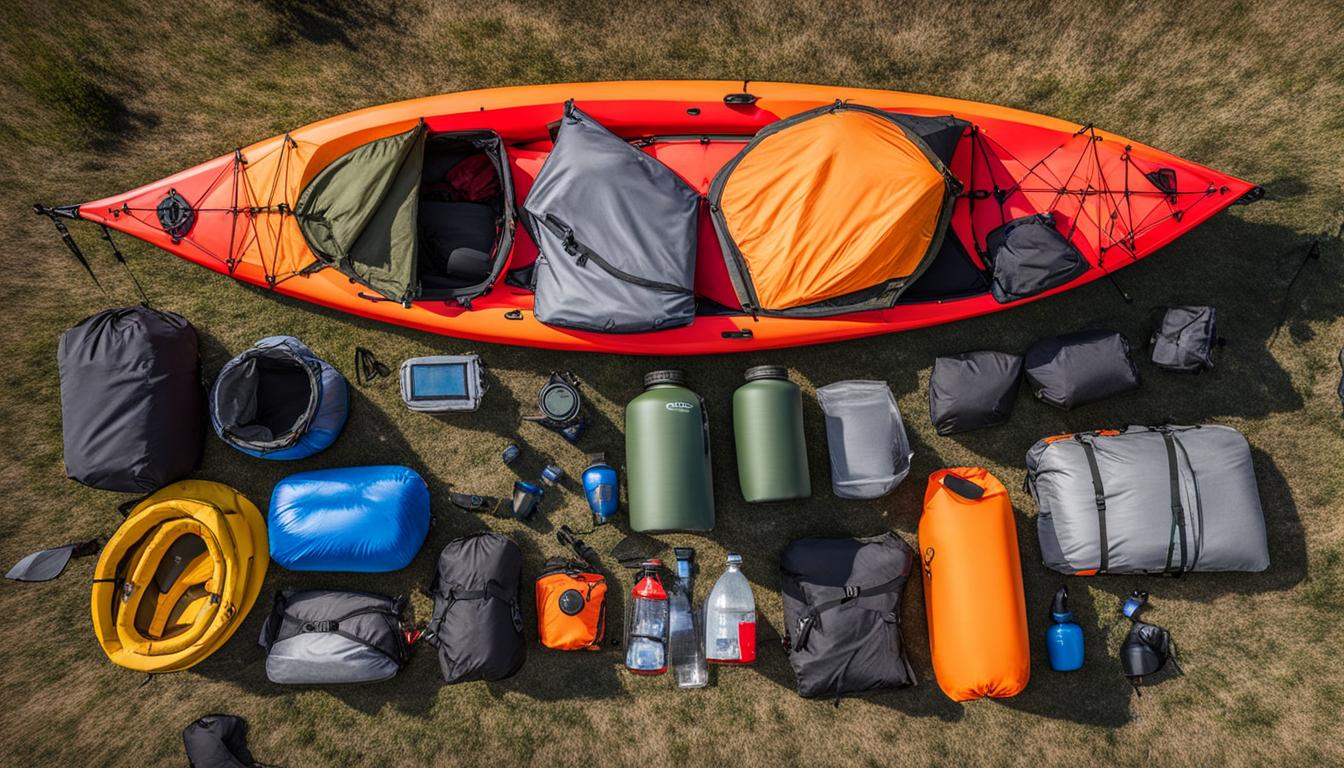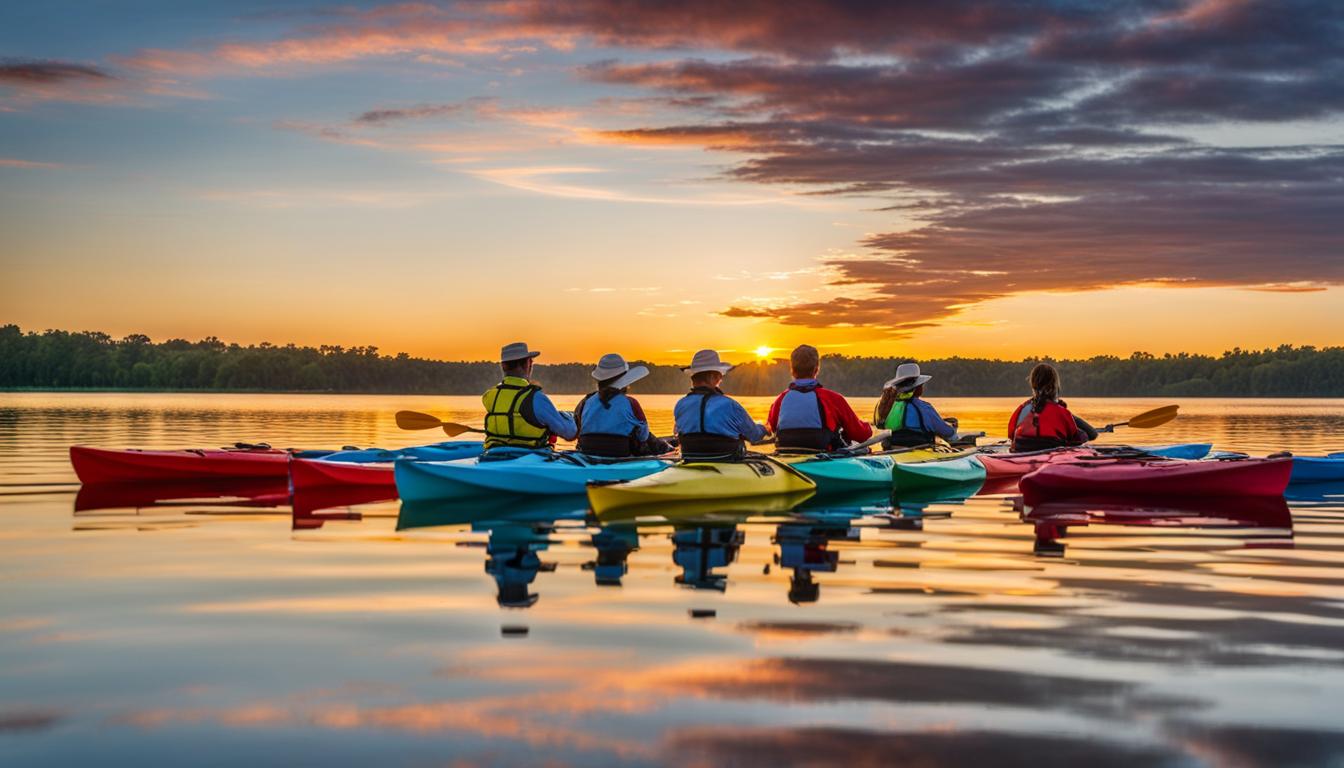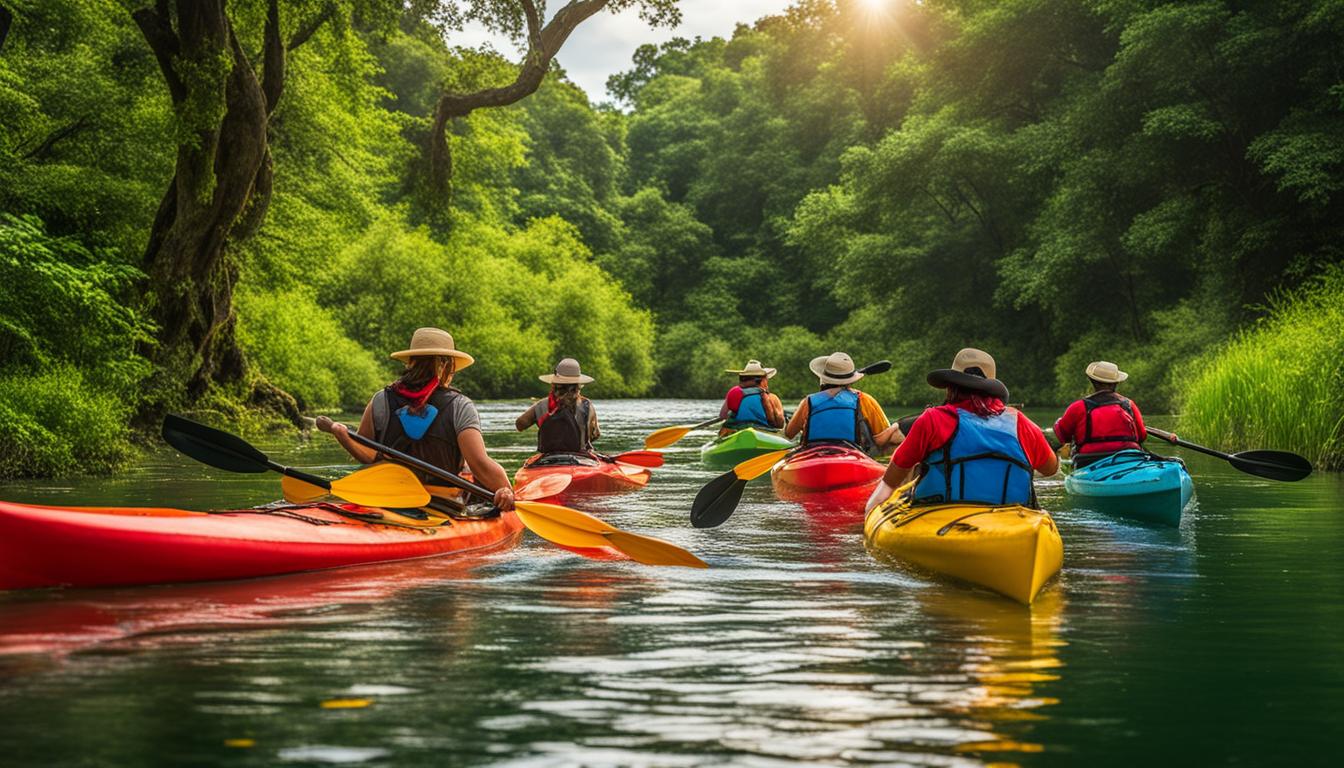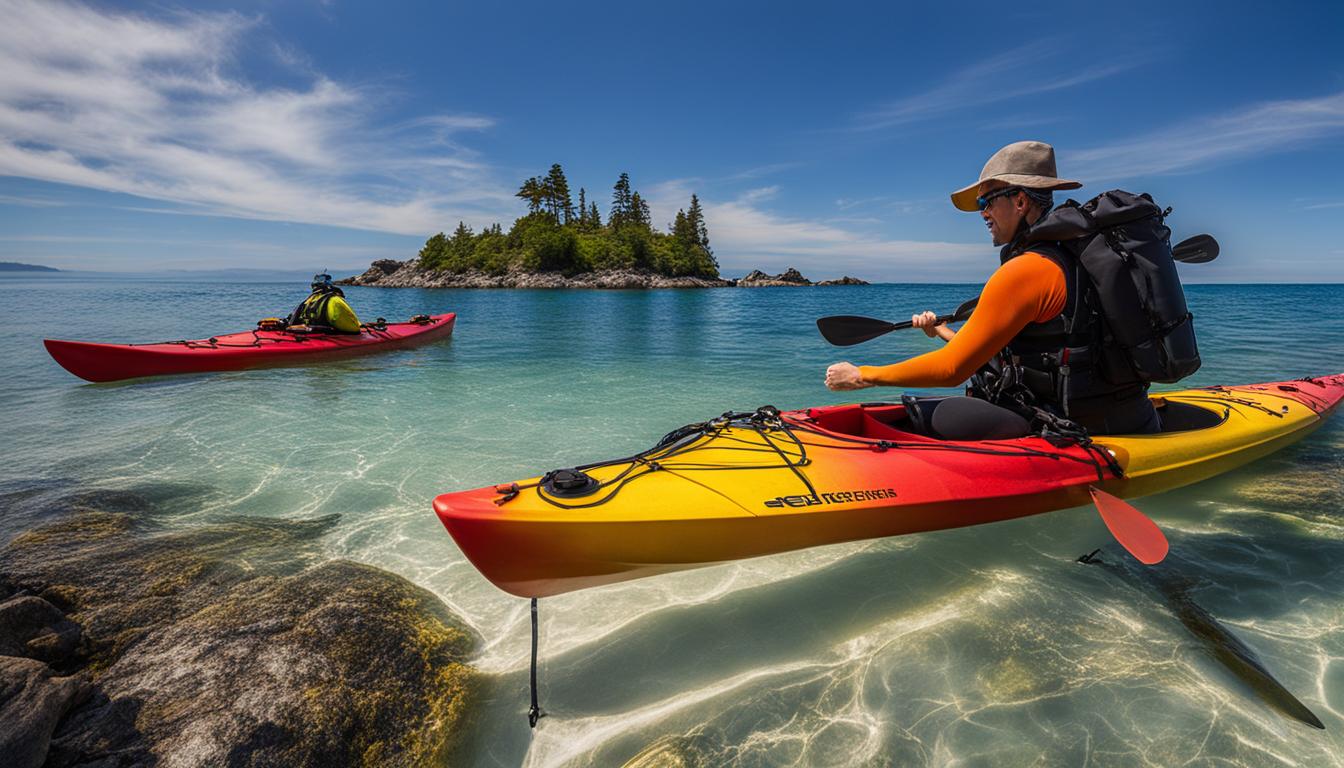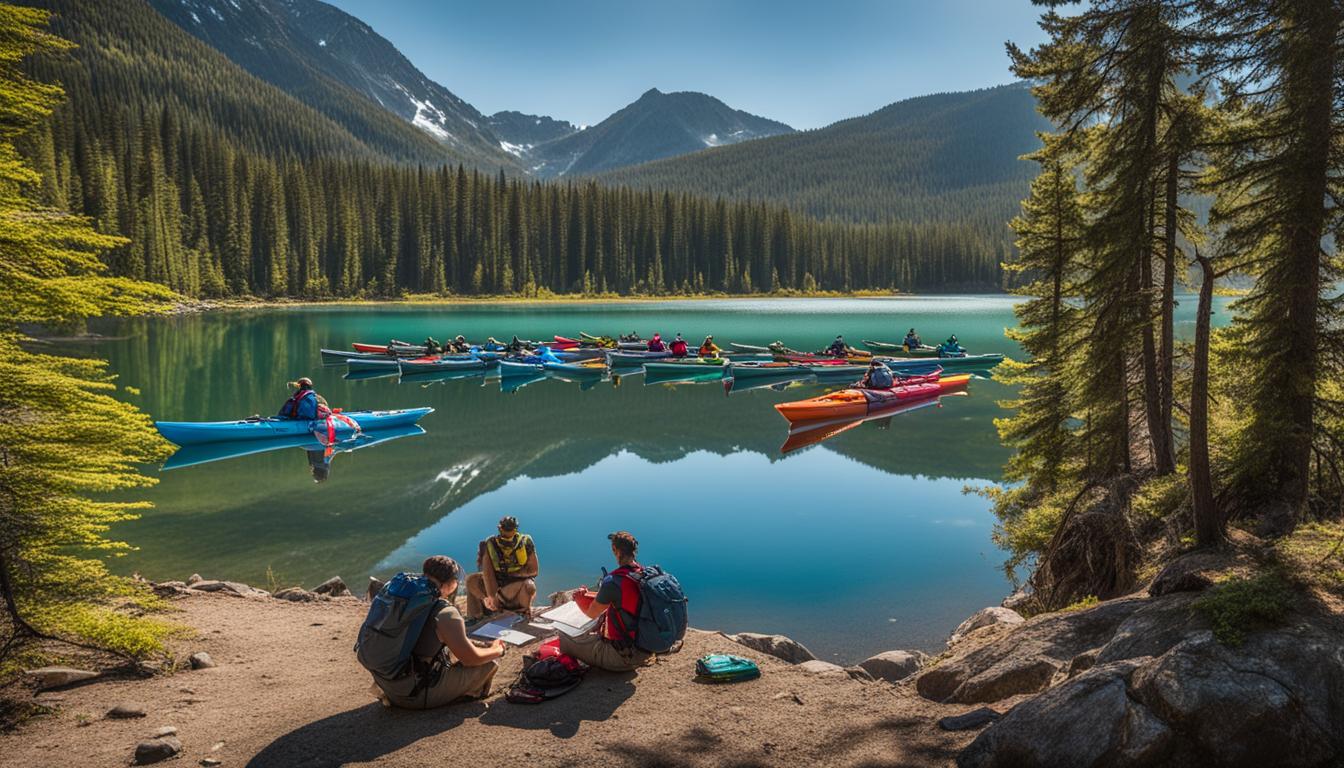When planning an overnight kayak trip, it’s important to have the right gear to ensure a safe and comfortable experience. From kayaks and paddles to personal flotation devices and camping equipment, here is a comprehensive list of essential gear you’ll need for your overnight kayak adventure.
Key Takeaways:
- Make sure to pack a kayak, paddle, and personal flotation device (PFD) for each paddler.
- Essential gear includes a bilge pump, spray skirt (for cold weather/water), dry bags, headlamp, and signaling whistle.
- Consider additional gear such as a paddle float, paddling knife, towline, maps, charts, compass, weather/VHF radio, etc. for extended trips.
- Dress for the water temperature, pack quick-drying, moisture-wicking clothing, neoprene footwear, and sun-shielding hats.
- Organize your gear in 12-to-15-liter dry bags, balance weight distribution, and keep frequently used items within easy reach.
Kayak Gear Essentials for Overnight Trips
When preparing for an overnight kayak trip, it’s crucial to have the right gear to ensure a safe and enjoyable adventure. In this section, we’ll explore the must-have kayak camping gear that every paddler should pack. From essential equipment to additional gear for extended trips, we’ve got you covered.
Kayak and Paddles
The first essential gear you’ll need is a reliable kayak and paddle. Choose a kayak that suits your needs and experience level, whether it’s a sit-on-top kayak or a touring kayak. Additionally, make sure to select a paddle that is lightweight, durable, and appropriate for your paddling style.
Personal Flotation Device (PFD)
A personal flotation device, or PFD, is a crucial piece of gear for every kayaker. Choose a PFD that is comfortable, properly fitted, and approved by the U.S. Coast Guard. Ensure that everyone in your group has their own PFD and wears it at all times while on the water.
Additional Essential Gear
Along with a kayak and paddle, there are several other essential gear items that you should pack for an overnight kayak trip. These include:
- A bilge pump to remove water from your kayak
- A spray skirt for cold weather or water conditions
- Dry bags to keep your personal items dry
- A headlamp or light with extra batteries for nighttime paddling
- A signaling whistle for emergency situations
For longer trips or overnight camping, it’s recommended to bring additional gear such as a paddle float, paddling knife, towline, maps and charts, compass, weather/VHF radio, and more. These items will help keep you safe and prepared for any situation that may arise during your kayak adventure.

Clothing and Footwear for Kayak Camping
When embarking on a kayak camping adventure, it’s crucial to select the appropriate clothing and footwear to ensure your comfort and safety throughout the trip. Choosing lightweight, durable gear that suits the conditions you’ll encounter is essential, whether you’re a beginner or experienced kayaker.
For clothing, opt for quick-drying and moisture-wicking fabrics that will keep you comfortable even if you get wet. Avoid cotton as it retains moisture and can leave you feeling chilled. Pack swimwear or shorts, rashguard tops or moisture-wicking shirts to protect your skin from the sun, neoprene footwear for added foot protection, sun-shielding hats to prevent sunburn, and paddling gloves to protect your hands from blisters and calluses.
Additionally, it’s important to dress appropriately for the water temperature. If you’re kayaking in colder weather or water, consider adding layers such as dry suits or tops, long underwear, synthetic or wool socks, and more to stay warm. Proper footwear is crucial, so select water shoes or sandals that provide both in-water and on-land functionality.
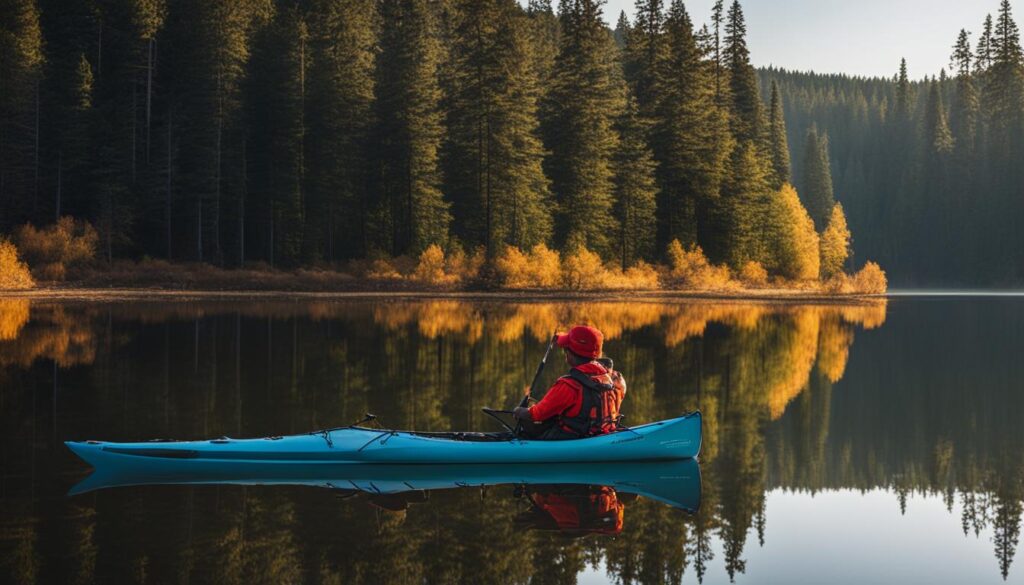
Remember, the right clothing and footwear can make all the difference in your comfort and enjoyment during your kayak camping experience. By choosing lightweight, durable gear suited to the conditions, you’ll be prepared for whatever comes your way.
Kayak Camping Gear: Packing and Organizing Essentials
When it comes to preparing for your overnight kayak trip, packing and organizing your gear properly is crucial. By following a few key strategies, you can ensure that your equipment is easily accessible, well-protected, and efficiently distributed in your kayak. Here are some recommended tips and techniques for packing and organizing your kayak camping gear.
Compartmentalize with Dry Bags
To keep your gear dry and organized, it’s best to use dry bags of various sizes. Opt for 12-to-15-liter dry bags, which are compact enough to fit inside your kayak’s hatches or compartments. Use smaller dry bags for items like electronics, food, and personal items, and larger bags for clothing and bulky gear. Make sure to roll down the tops of the bags tightly and secure them with their respective closures to create a watertight seal.
Distribute Weight Strategically
When loading your kayak, consider distributing the weight of your gear evenly to maintain stability and maneuverability. Place heavier items, such as cookware, water containers, and stove fuel, closest to the seat and inside the kayak’s center of gravity. Lighter items, like clothing and sleeping gear, can be stored towards the bow or stern areas. This arrangement will help maintain balance and ensure a smooth paddling experience.
Create an Accessible Layout
To make your gear easily accessible during your kayaking journey, organize your items in order of necessity. Keep frequently used items, such as snacks, water bottles, and navigation tools, within arm’s reach. Place less frequently used items, like extra clothing and camping gear, towards the bottom of your kayak’s compartments. Consider using mesh pockets or small containers for storing small accessories like sunscreen, bug repellent, and first aid supplies.
By following these packing and organizing guidelines, you can optimize your kayak camping experience by ensuring that your gear is well-protected, easily accessible, and efficiently distributed in your kayak. This will allow you to fully enjoy your overnight trip and focus on the beauty of nature surrounding you.
Kayak Camping: Food and Water Essentials
When embarking on a kayak camping trip, it’s crucial to pack the right food and ensure you have an adequate supply of water. Proper nutrition and hydration are essential for staying energized and maintaining your stamina throughout the adventure. In this section, we’ll explore the key considerations for food and water on your kayak camping journey.
Food for Kayak Camping
Unlike backpacking, kayak camping allows for more flexibility when it comes to food choices. You can enjoy hearty, calorie-dense meals that can be cooked over a fire or on a backpacking stove. Consider packing lightweight, dehydrated meals that are easy to prepare and provide the necessary nutrients for your outdoor excursion. Additionally, include snacks like energy bars, dried fruits, nuts, and trail mix to keep your energy levels high during the day. Don’t forget to bring a lightweight cookware set and utensils for meal preparation.
Water for Kayak Camping
Ensuring an adequate supply of water is crucial for your kayak camping trip. Depending on the duration of your adventure and the availability of water sources along your route, you need to plan accordingly. It’s recommended to carry enough water to last for the duration of your trip and have a backup plan in case you need to replenish your supply. Consider using lightweight water storage bags that roll up when empty and sit low in your kayak when full. If you are paddling in areas with access to potable water sources, a filtration pump can be useful for purifying water as you go.
Table: Food and Water Essentials
| Food | Water |
|---|---|
| Lightweight, dehydrated meals | Water storage bags |
| Energy bars | Filtration pump |
| Dried fruits | |
| Nuts and trail mix | |
| Cookware set and utensils |
Remember, staying hydrated and well-fed is vital for a successful kayak camping trip. Plan your meals and water supply ahead of time, and always be mindful of proper food storage and waste disposal while enjoying the great outdoors.
Conclusion
Planning and packing the right gear for an overnight kayak trip is essential to ensure a safe and enjoyable experience. From choosing the right kayak and paddle to packing clothing, camping gear, and food, this comprehensive guide provides all the information you need to embark on your kayak camping adventure.
Remember to always prioritize safety and consult with experienced paddlers or guides when necessary. Investing in essential equipment for kayak camping, such as personal flotation devices, bilge pumps, and dry bags, will enhance your comfort and preparedness on the water.
If you’re an advanced kayaker looking for even more specialized gear, consider adding additional items like a paddle float, towline, and weather/VHF radio to your arsenal. These advanced kayak camping equipment can provide extra safety and convenience during your trip.
FAQ
What gear do I need for an overnight kayak trip?
For an overnight kayak trip, you’ll need a kayak and paddle, personal flotation devices (PFDs) for each paddler, a bilge pump, spray skirt (for cold weather/water), dry bags for personal items, a headlamp or light with extra batteries, and a signaling whistle. Additional gear like a paddle float, paddling knife, towline, maps and charts, compass, and weather/VHF radio are also recommended for extended trips.
What clothing and footwear should I pack for kayak camping?
When it comes to clothing for kayak camping, opt for quick-drying, moisture-wicking materials and avoid cotton. Pack swimwear or shorts, rashguard tops or moisture-wicking shirts, neoprene footwear, sun-shielding hats, and paddling gloves. For colder weather/water, add dry suits or tops, long underwear, synthetic or wool socks, and more. It’s important to have water shoes or sandals that offer both in-water and on-land functionality.
How should I pack and organize my gear for an overnight kayak trip?
When packing your gear, use 12-to-15-liter dry bags to compartmentalize your items. Place the heaviest items closest to your seat and the lightest items farthest away to balance the weight. Organize your gear in order of necessity and keep frequently used items within easy reach. Consider using trash compactor bags to keep your gear dry and opt for clear dry bags to easily see the contents. Tyvek sheets can also be used as a sleeping and changing tarp.
What should I bring for food and water on a kayak camping trip?
When it comes to food, you have more flexibility compared to backpacking. Enjoy calorie-dense meals cooked over a fire or on a backpacking stove. Be sure to bring enough water for your trip, and consider using a filtration pump for lakes or planning your campsites near potable water sources. Lightweight water storage bags that roll up when empty and sit low in your kayak when full are recommended.
Can you provide a summary of essential gear for an overnight kayak trip?
When planning an overnight kayak trip, essential gear includes a kayak, paddle, personal flotation devices (PFDs), bilge pump, spray skirt, dry bags, headlamp or light with extra batteries, and a signaling whistle. Additional gear like a paddle float, paddling knife, towline, maps and charts, compass, and weather/VHF radio are recommended for extended trips. Proper clothing and footwear, as well as organized packing and sufficient food and water, are also important for a successful kayak camping adventure.

